RENAULT Vel Satis User Manual
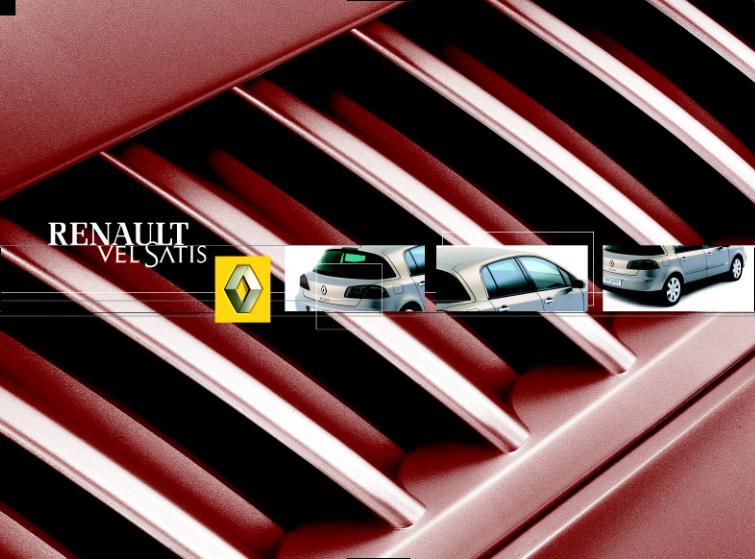
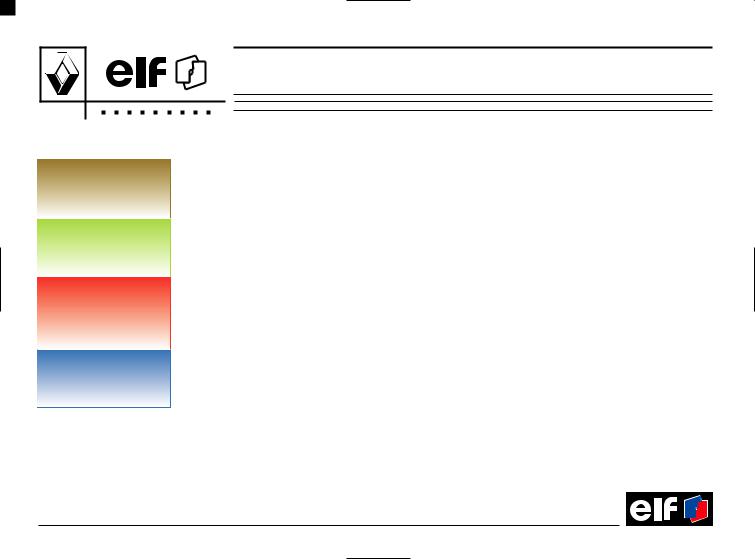
RENAULT recommends ELF
For all engines
For all
petrol engines
For all engines except 3.0 dCi diesel
Manual gearbox Automatic gearbox
ELF EXCELLIUM LDX 5W-40 |
ACEA A3 / B3 / B4 |
ELF ULTIMATE 5W-40 |
|
Premium performance and engine care. Recommended for this vehicle |
|
|
|
ELF EVOLUTION SXR 5W-30 |
ACEA A5 / B5 |
ELF ELITE PREMIER PLUS 5W-30 |
ACEA A1 / B1 |
Fuel savings, engine care and protecting the environment |
|
|
|
ELF COMPETITION ST 10W-40 |
ACEA A3 / B3 |
ELF PREMIER PLUS 10W-40 |
ACEA A3 / B3 |
ELF TURBO DIESEL 10W-40 |
ACEA B3 / B4 |
Other types of lubricants approved by RENAULT for petrol of diesel engines |
|
|
|
TRANSELF TRJ 75W-80 |
API GL5 |
Please contact your RENAULT dealer
RENAULT recommends ELF approved lubricants.
For top-ups or oil drain, we recommend you to use only original lubricants.
For further information, please contact you RENAULT dealer or go to www.lubricants.elf.com
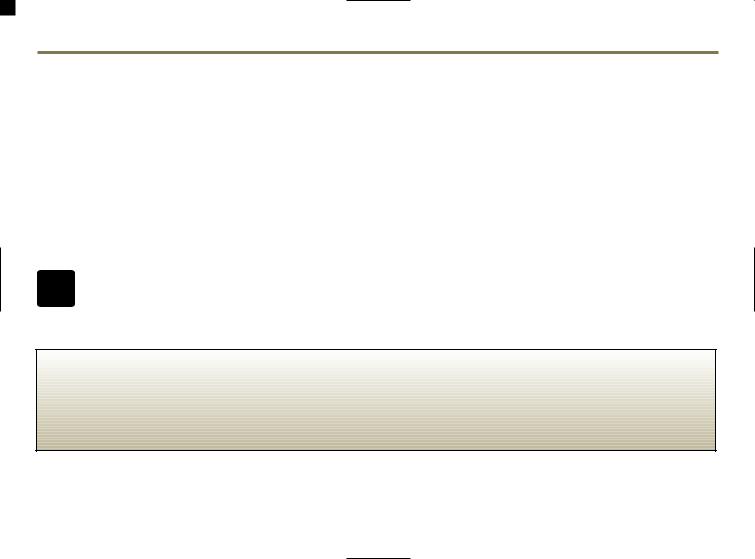
Welcome to your new RENAULT
This driver’s handbook contains the information necessary:
•to enable you to get to know your RENAULT, to use it to the best advantage and to benefit from all the latest technical developments which are incorporated in it.
•to ensure that it always gives the best performance by following the simple, but strict, advice concerning regular maintenance.
•to enable you to deal quickly with minor faults not requiring specialist attention.
It is well worth taking a few minutes to read this handbook to familiarise yourself with the information and guidelines it contains about the vehicle and its innovative features. If certain points are still unclear, the technicians in our Network will be only too pleased to provide you with any additional information you require.
To help you when reading this handbook, you will find the following symbol:
To indicate a hazard, danger or safety advice.
The description of the models given in this handbook is based on the technical specifications at the time of writing. This
handbook covers all equipment (both standard and optional) available for these models but whether or not this is fitted
to the vehicle depends on the version, options selected and the country in which the vehicle is sold.
This handbook may also contain information about items of equipment to be introduced later in the model year.
Enjoy driving your new RENAULT.
Copying or translation, in part or in full, is forbidden unless prior written permission has been obtained from RENAULT, 92100 Billancourt 2003.
0.01
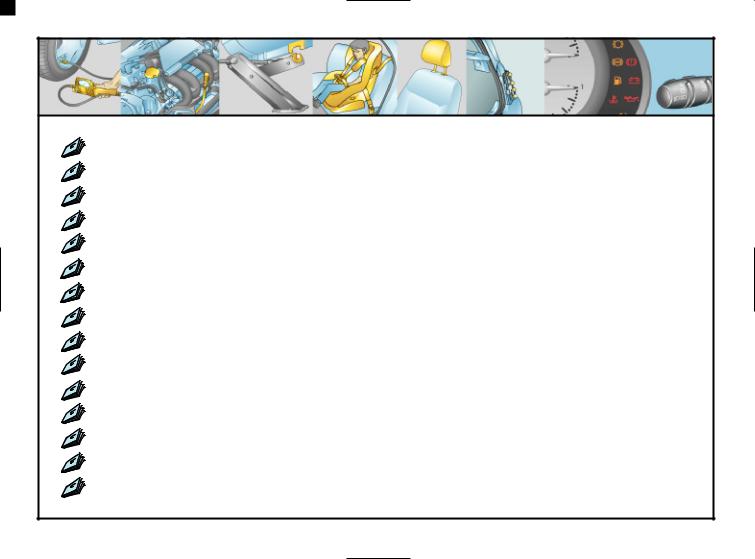
Brief overview
• Tyre pressures ............................................................................................ |
0.04 |
0.07 |
|
• RENAULT Card: use .................................................................................. |
1.02 1.09 |
||
• Child restraints .......................................................................................... |
1.36 |
1.47 |
|
• Warning lights (instrument panel) ........................................................... |
1.52 |
1.67 |
|
• Starting/stopping the engine ...................................................................... |
2.02 |
- 2.03 |
|
• Driving ........................................................................................................ |
2.02 2.46 |
||
Automatic parking brake ...................................................................... |
2.08 - 2.09 |
||
Tyre pressure monitor ......................................................................... |
2.14 |
2.18 |
|
Electronic Stability Program: ESP ....................................................... |
2.19 |
- 2.20 |
|
Traction control ..................................................................................... |
2.21 |
- 2.22 |
|
Emergency brake assist .................................................................................... |
|
|
2.25 |
Cruise control / speed limiter ............................................................ |
2.26 |
2.41 |
|
Parking proximity sensor ..................................................................... |
2.42 |
- 2.43 |
|
• Air conditioning ........................................................................................ |
3.02 3.13 |
||
• Bonnet/maintenance .................................................................................. |
4.02 4.14 |
||
• Practical advice (changing bulbs, fuses, breakdown, faults) ................ |
5.02 |
5.36 |
|
0.02
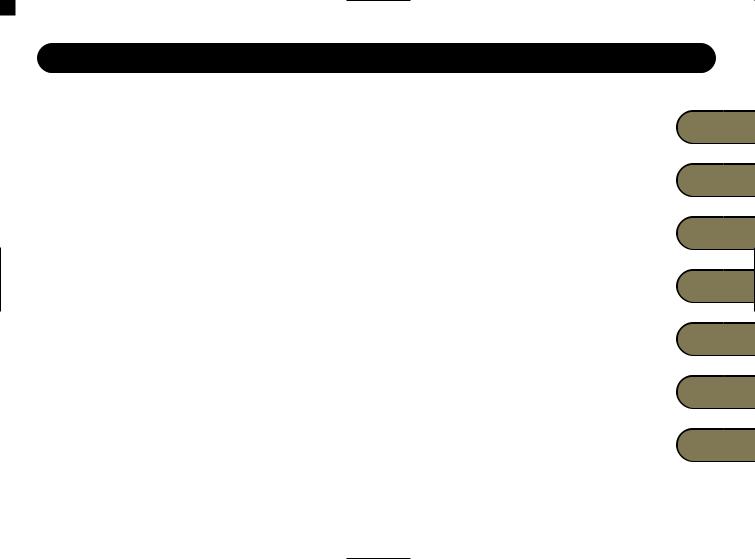
C |
O |
N |
T |
E |
N |
T |
S |
|
|
|
|
|
|
|
Sections |
Getting to know your vehicle |
............................................................ |
|
|
1 |
|||
Driving |
............................................................................................................... |
|
|
|
|
|
2 |
Your comfort ................................................................................................. |
|
|
|
|
|
3 |
|
Maintenance .................................................................................................. |
|
|
|
|
|
4 |
|
Practical advice |
........................................................................................... |
|
|
|
|
5 |
|
Technical specifications |
........................................................................ |
|
|
|
6 |
||
Alphabetical index .................................................................................... |
|
|
|
|
7 |
||
0.03
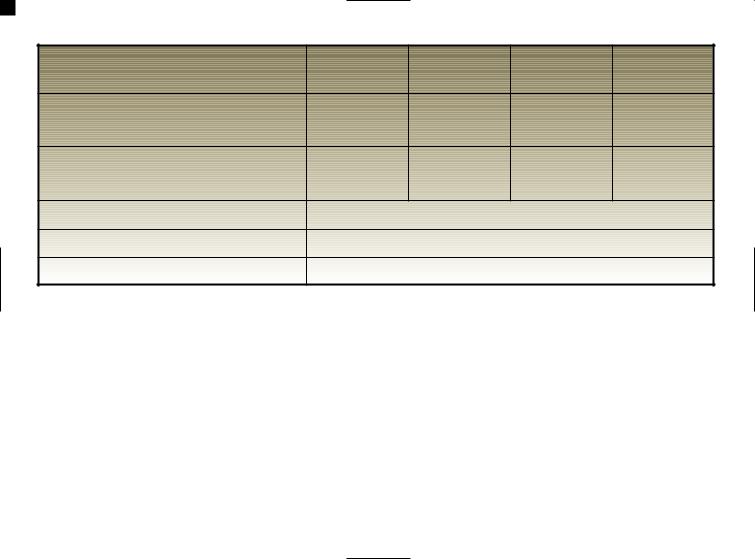
TYRE PRESSURES in bar or kg/cm² (when cold)
Versions fitted with 17” wheels |
2.0 T |
3.5 V6 |
2.2 dCi |
3.0 dCi |
Non-motorway use |
|
|
|
|
• Front |
2.1 |
2.2 |
2.2 |
2.3 |
• Rear |
2.0 |
2.0 |
2.0 |
2.0 |
Motorway use (1) |
|
|
|
|
• Front |
2.2 |
2.5 |
2.3 |
2.4 |
• Rear |
2.0 |
2.0 |
2.0 |
2.0 |
Spare wheel |
|
|
3.3 |
|
Wheel sizes |
|
7 J 17 - 5.5 J 17 (spare wheel) |
|
|
Tyre sizes |
|
225/55 R 17 W - 185/60 R 17 C (spare wheel) |
|
|
Tyre safety and snow chains
Refer to the Tyres information in Section 5 for information on maintenance and, depending on the version, the conditions under which snow chains may be used.
(1)Special note concerning vehicles used under full load (Maximum Permissible All-up Weight) and towing a trailer. The maximum speed must be limited to 60 mph (100 km/h) and the tyre pressure increased by 0.2 bar.
Refer to the information on Weights in Section 6 for more details.
0.04
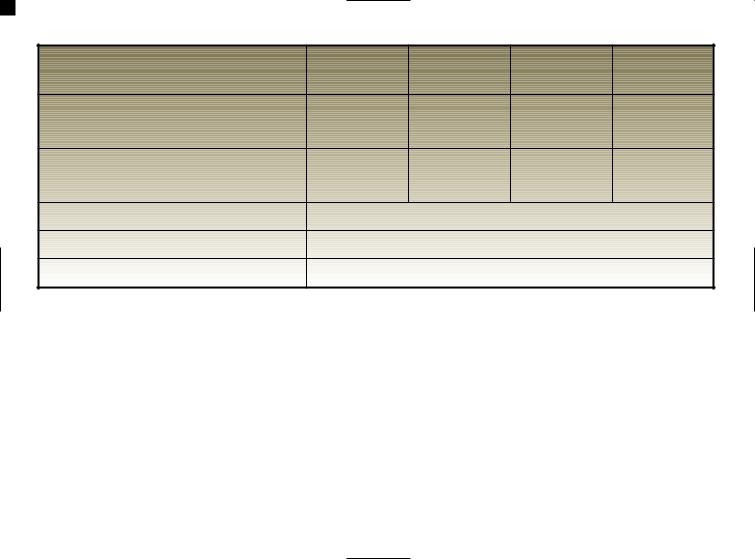
TYRE PRESSURES in bar or kg/cm² (when cold) (continued)
Versions fitted with 18” wheels |
2.0 T |
3.5 V6 |
2.2 dCi |
3.0 dCi |
Non-motorway use |
|
|
|
|
• Front |
2.1 |
2.3 |
2.3 |
2.4 |
• Rear |
2.0 |
2.0 |
2.0 |
2.0 |
Motorway use (1) |
|
|
|
|
• Front |
2.2 |
2.6 |
2.4 |
2.5 |
• Rear |
2.0 |
2.0 |
2.0 |
2.0 |
Spare wheel |
|
|
3.3 |
|
Wheel sizes |
|
7.5 J 18 - 5.5 J 17 (spare wheel) |
|
|
Tyre sizes |
|
245/45 R 18 W - 185/60 R 17 C (spare wheel) |
|
|
Tyre safety and snow chains
Refer to the Tyres information in Section 5 for information on maintenance and, depending on the version, the conditions under which snow chains may be used.
(1)Special note concerning vehicles used under full load (Maximum Permissible All-up Weight) and towing a trailer. The maximum speed must be limited to 60 mph (100 km/h) and the tyre pressure increased by 0.2 bar.
Refer to the information on Weights in Section 6 for more details.
0.05
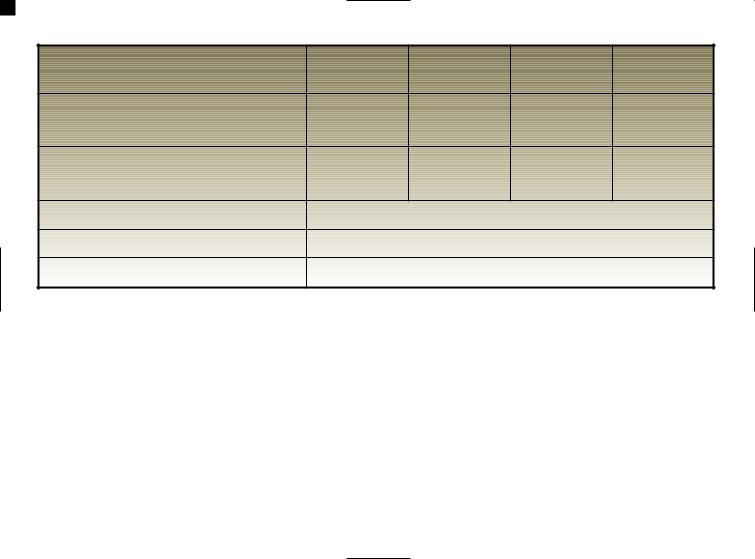
TYRE PRESSURES in PSI (when cold)
Versions fitted with 17” wheels |
2.0 T |
3.5 V6 |
2.2 dCi |
3.0 dCi |
Non-motorway use |
|
|
|
|
• Front |
30 |
32 |
32 |
33 |
• Rear |
29 |
29 |
29 |
29 |
Motorway use (1) |
|
|
|
|
• Front |
32 |
36 |
33 |
35 |
• Rear |
29 |
29 |
29 |
29 |
Spare wheel |
|
|
47 |
|
Wheel sizes |
|
7 J 17 - 5,5 J 17 (spare wheel) |
|
|
Tyre sizes |
|
225/55 R 17 W - 185/60 R 17 C (spare wheel) |
|
|
Tyre safety and snow chains
Refer to the Tyres information in Section 5 for information on maintenance and, depending on the version, the conditions under which snow chains may be used.
(1)Special note concerning vehicles used under full load (Maximum Permissible All-up Weight) and towing a trailer. The maximum speed must be limited to 60 mph (100 km/h) and the tyre pressure increased by 3 PSI.
Refer to the information on Weights in Section 6 for more details.
0.06
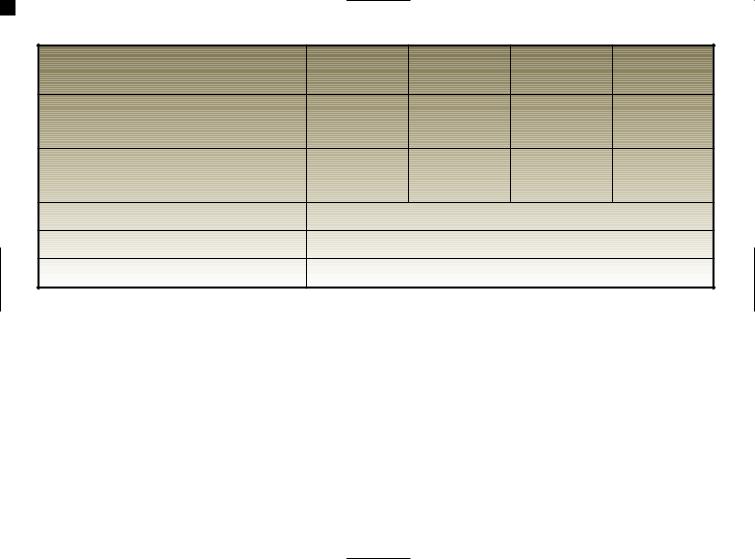
TYRE PRESSURES in PSI (when cold) (continued)
Versions fitted with 18” wheels |
2.0 T |
3.5 V6 |
2.2 dCi |
3.0 dCi |
Non-motorway use |
|
|
|
|
• Front |
30 |
33 |
33 |
35 |
• Rear |
29 |
29 |
29 |
29 |
Motorway use (1) |
|
|
|
|
• Front |
32 |
38 |
35 |
36 |
• Rear |
29 |
29 |
29 |
29 |
Spare wheel |
|
|
47 |
|
Wheel sizes |
|
7,5 J 18 - 5,5 J 17 (spare wheel) |
|
|
Tyre sizes |
|
245/45 R 18 W - 185/60 R 17 C (spare wheel) |
|
|
Tyre safety and snow chains
Refer to the Tyres information in Section 5 for information on maintenance and, depending on the version, the conditions under which snow chains may be used.
(1)Special note concerning vehicles used under full load (Maximum Permissible All-up Weight) and towing a trailer. The maximum speed must be limited to 60 mph (100 km/h) and the tyre pressure increased by 3 PSI.
Refer to the information on Weights in Section 6 for more details.
0.07

0.08
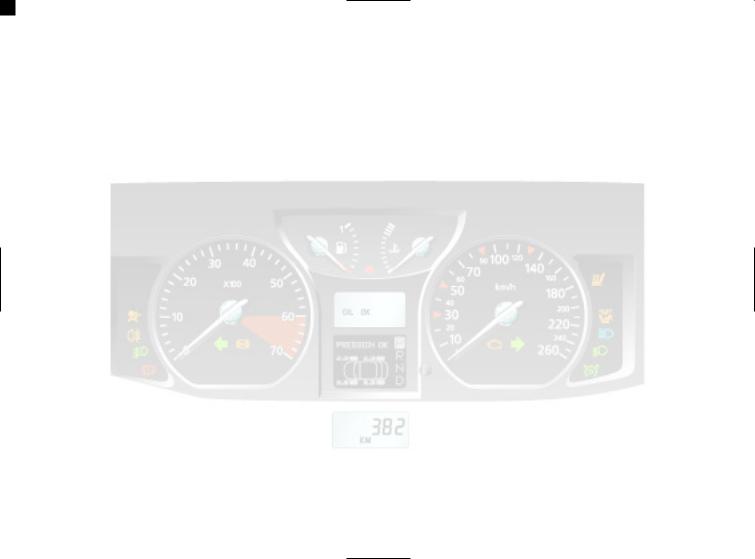
Section 1: Getting to know your vehicle
RENAULT Card: general information, use, deadlocking ............................................................... |
1.02 1.09 |
||
Doors .................................................................................................................................................. |
1.10 1.15 |
||
Engine immobiliser system ................................................................................................................ |
1.16 - 1.17 |
||
Headrests / Seats ............................................................................................................................... |
1.18 1.23 |
||
Steering wheel ................................................................................................................................................ |
|
1.24 |
|
Seat belts ............................................................................................................................................ |
1.25 1.28 |
||
Additional methods of restraint ..................................................................................................... |
1.29 1.35 |
||
to the front seat belts ............................................................................... |
1.29 |
1.32 |
|
to the rear seat belts ............................................................................................. |
|
1.33 |
|
lateral ..................................................................................................................... |
|
1.34 |
|
Child safety ........................................................................................................................................ |
1.36 1.47 |
||
Deactivating the front passenger airbag .......................................................................................... |
1.40 1.42 |
||
Driving position ................................................................................................................................. |
1.48 1.51 |
||
Instrument panel ............................................................................................................................... |
1.52 1.67 |
||
Information display ....................................................................................................................... |
1.58 1.63 |
||
Trip computer and Warning System ............................................................................................ |
1.64 1.67 |
||
Voice synthesiser ................................................................................................................................. |
1.68 - 1.69 |
||
Clock and external temperature .................................................................................................................... |
|
|
1.70 |
|
|
||
Rear-view mirrors ................................................................................................................................ |
|
1.71 - 1.72 |
|
Audible and visible signals ........................................................................................................................... |
|
|
1.73 |
Lighting and exterior signals |
|
1.74 1.77 |
|
|
|||
Headlight beam adjustment .......................................................................................................................... |
|
1.77 |
|
Washers / Wipers .............................................................................................................................. |
1.78 1.80 |
||
Fuel tank (filling with fuel) .............................................................................................................. |
1.81 1.83 |
||
1.01
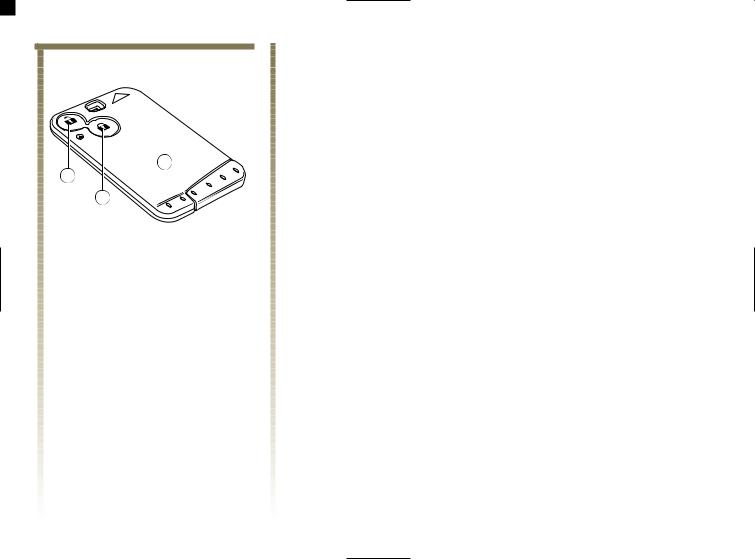
RENAULT CARD: general information
18249
A
1
2
Remote control RENAULT Card A
The card has two buttons, 1 and 2.
It allows:
-the doors (inc. tailgate) and the fuel filler flap to be locked or unlocked (see the following pages);
-depending on the vehicle, automatic closure of windows and the sunroof (see the Electric window with automatic closing and Sunroof information in Section 3);
-operation of certain devices (e.g.: radio, electrically controlled seats, etc.);
-the engine to be started (see the information on Starting the engine in Section 2).
1.02
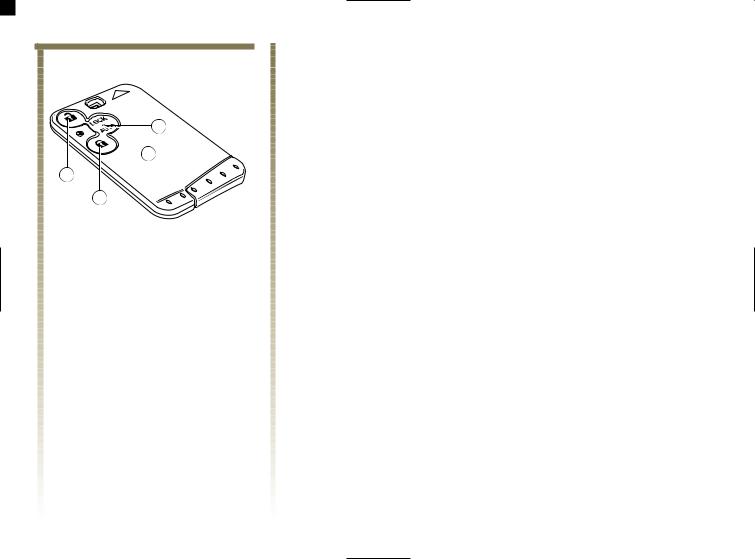
RENAULT Card: general information (continued)
18249.1
3
B
1
2
RENAULT Card in hands-free mode B
This card has three buttons, 1, 2 and 3.
It allows:
-the doors (inc. tailgate) and fuel filler flap to be locked or unlocked automatically if required;
-the doors (inc. tailgate) and the fuel filler flap to be locked or unlocked intentionally (see the following pages);
-depending on the vehicle, automatic closure of windows and the sunroof (see the Electric window with automatic closing and Sunroof information in Section 3);
-operation of certain devices (e.g.: radio, electrically controlled seats, etc.);
-starting the engine (see the information on Starting the engine in Section 2).
1.03
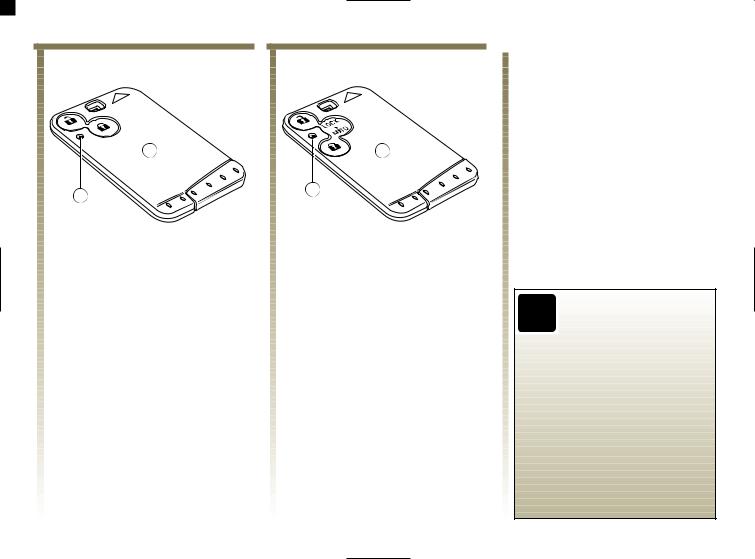
RENAULT Card: general information (continued)
18249 |
18249.1 |
A |
B |
4 |
4 |
|
 Remote control range
Remote control range
This varies according to the environment. It is therefore important to take care when handling the RENAULT Card that you do not inadvertently lock or unlock the doors.
RENAULT Cards A and B are supplied with a battery which should be replaced when battery warning light 4 no longer lights up (see the RENAULT Card: battery information in Section 5)
Special note: on some vehicles, the RENAULT Card can record settings selected by the card user for some radios, electrical seat adjustments (if stored), the position of the door mirrors, automatic air conditioning settings, etc. We therefore recommend that you keep the same RENAULT Card at all times so that you can retrieve your personal settings.
Never leave your vehicle
unattended with the
RENAULT Card still
inserted in the card
reader when a child (or a pet) is
in the vehicle. They might start
the engine or operate electrical
equipment such as the electric
windows and there is a risk that
they may trap part of their body
(neck, arms, hands, etc.). Risk of
serious injury.
1.04
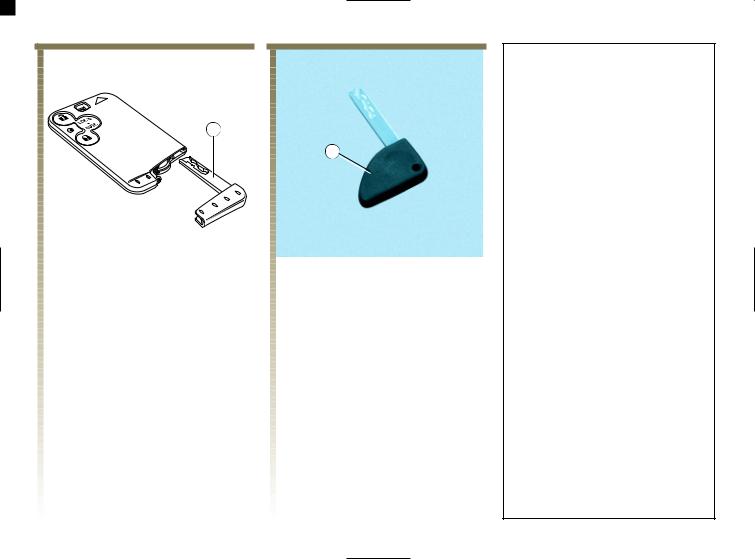
RENAULT Card: general information (continued)
18249.2
5
6 |
Integral emergency key 5 or separate emergency key 6
(depending on vehicle)
It is only for use in exceptional circumstances it is used to lock and unlock the left-hand door when the RENAULT card is not functioning correctly:
-vehicle located in a zone of high electromagnetic radiation;
-use of devices using the same frequency as the card;
-flat RENAULT Card battery, discharged battery, etc.
For instructions on how to use the emergency key, see the Locking/ unlocking the doors section.
Once you have entered the vehicle with the emergency key, insert the RENAULT Card into the card reader in order to start the vehicle.
Replacement, need for an additional RENAULT Card
If you lose your RENAULT Card or require another, you can obtain one from your Dealer.
If a RENAULT Card is replaced, it will be necessary to take the vehicle to your RENAULT Dealer because both the vehicle and all the RENAULT Cards are needed to initialise the system.
You can use up to four RENAULT cards per vehicle.
A vehicle can only have one hands-free RENAULT Card. The other RENAULT Cards are remote control cards.
Faulty RENAULT Card.
Make sure that the batteries are always in good condition: they have a service life of approximately two years.
See the RENAULT Card: batteries information in Section 5.
1.05
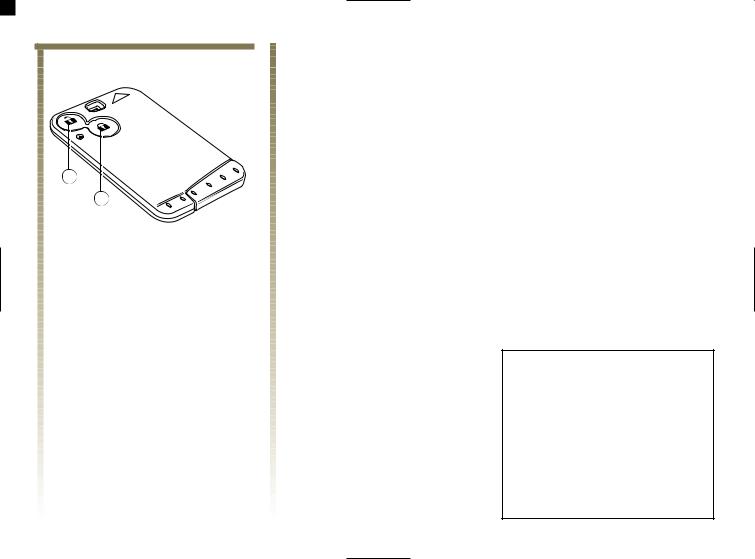
REMOTE CONTROL RENAULT CARD: use
|
18249 |
Locking the doors |
|
Press the locking button 2. |
|
|
|
|
|
|
The hazard warning lights flash |
|
|
twice to indicate that the doors have |
|
|
been locked. |
|
|
- If the driver's door is open or not |
|
|
closed properly, the doors and |
|
|
tailgate will not be locked and the |
|
|
hazard warning lights will not |
1 |
|
flash. |
2 |
- If one of the doors or the tailgate is |
|
open or not closed properly, the |
||
|
||
|
hazard warning lights will not |
|
|
flash. |
Unlocking the doors
Press the unlocking button 1.
The hazard warning lights flash once to indicate that the doors have been unlocked.
Special note (for some countries):
-The driver's door only can be opened by pressing button 1,
-All the doors can be opened by pressing button 1 a second time.
Advice
Do not keep your RENAULT Card in a place where it could be bent or damaged accidentally, such as in a back pocket where you might sit on it.
1.06
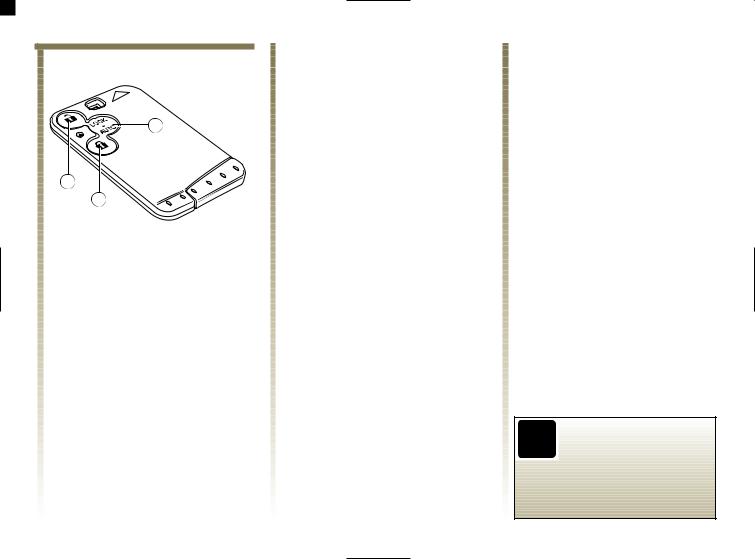
RENAULT CARD IN HANDS-FREE MODE: use
18249.1
3
1
2
Hands-free card
(for certain countries) Unlocking the doors
Walk up to your vehicle carrying your RENAULT Card.
As soon as you grip one of the handles (doors or tailgate), the locks will open automatically.
The hazard warning lights flash once to indicate that the doors have been unlocked.
Locking the doors
Close the doors and walk away from the vehicle carrying your RENAULT Card; the doors will lock automatically.
Note: the locking distance for your vehicle depends on the environment.
The hazard warning lights flash twice and the side repeater indicators light up (for approximately ten seconds) to indicate that the doors have been locked. A beep also sounds.
You can select the beep from a list of different tones or you can cancel it; consult your RENAULT Dealer.
Special note: for vehicles not equipped with the automatic remote control door locking function (for some countries), press button 3 to lock the doors.
Voluntary locking using the hands-free mode
The doors and tailgate can be locked instantly by pressing button 3 and you can check that they are locked by pulling one of the handles.
Automatic mode is operational again after approximately 3 seconds.
Note:
-if the RENAULT Card remains close to the vehicle, we recommend that you use button 2 to lock it;
-if you will not be using the vehicle
for a long time (more than 3 weeks) we recommend that you use button 2 to lock it in order to save the battery charge.
Never leave your vehicle
without removing the
RENAULT Card.
1.07
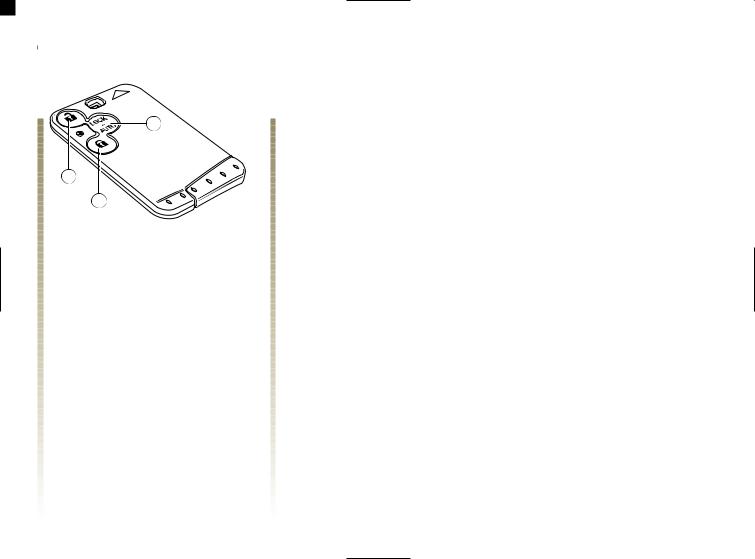
RENAULT CARD IN HANDS-FREE MODE: use (continued)
|
|
|
|
Returning to Hands-Free mode |
|
18249.1 |
|
|
hands-free mode. |
|
|
|
|
Press button 3 to return to |
|
|
|
|
|
|
|
|
|
|
|
|
|
|
|
|
|
|
|
|
|
|
|
|
|
3
1
2
Operation in manual mode
If you wish, you can exit the hands-free mode by pressing button 1 or 2; you will then be in manual mode and the RENAULT Card can be used following the method described in the Remote control RENAULT Card: use section.
1.08
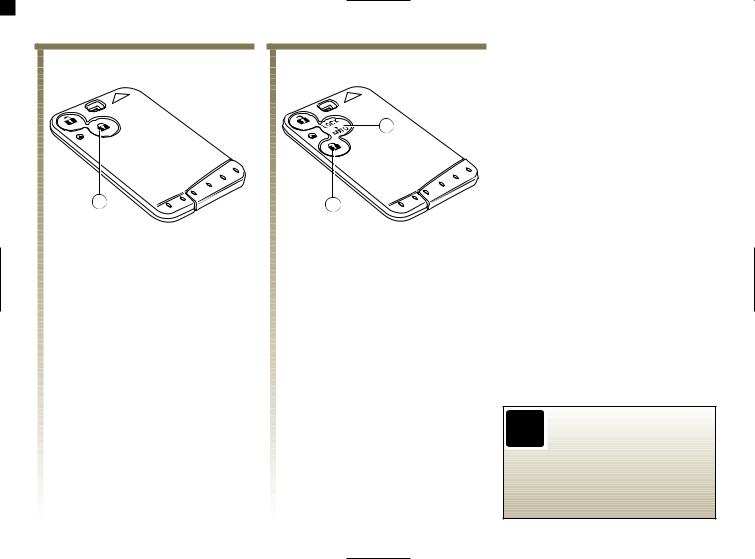
DEADLOCKING
18249 |
18249.1 |
3
2 |
2 |
Deadlocking the doors and tailgate
(for some countries)
This allows you to lock the doors and tailgate and to prevent the doors from being unlocked with the interior handles (for example, by breaking the window and then trying to open the door from the inside).
To activate deadlocking:
-press button 2 or 3 twice briefly;
-press and hold button 2 or 3.
The hazard warning lights flash four times to indicate that the doors have been locked.
Special note: deadlocking is not possible if the hazard warning lights or the side lights are lit.
Never use deadlocking if
someone is still inside the
vehicle.
1.09
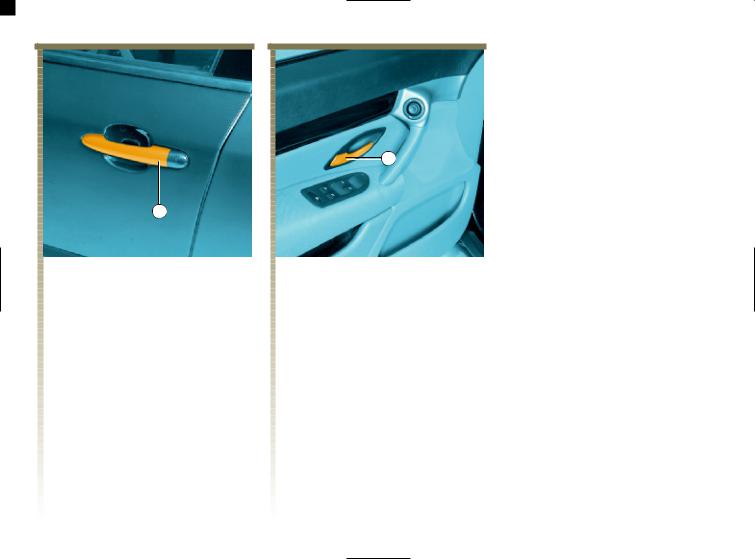
OPENING AND CLOSING THE DOORS
1
Opening the doors from the outside
Once the doors have been unlocked using the RENAULT Card, grasp the handle 1 and pull it towards you to open the door.
2
Opening the doors from the inside
Pull handle 2.
Lights on warning buzzer
A warning buzzer will sound when a door is opened if you have left the lights switched on after turning off the ignition (to prevent discharge of the battery, etc).
1.10
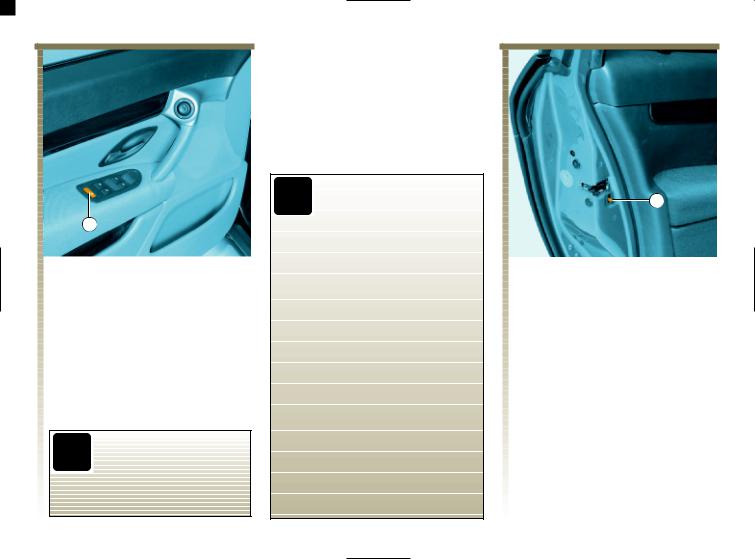
OPENING AND CLOSING THE DOORS (continued)
3
Child safety
Vehicles fitted with switch 3 with integrated indicator light
Press switch 3 to inhibit operation of the rear electric windows and, depending on the vehicle, rear door locking.
The indicator light built into the switch lights up to confirm that the doors are locked.
If there is a fault, you will
hear a beep and the
indicator light will not
light up.
Safety of rear occupants
The driver can inhibit
operation of the rear electric windows and door
by pressing switch 3 on the drawing side.
Driver's responsibility
Never leave your vehicle without removing the RENAULT Card from
inside and never leave a child (or a pet) unsupervised. With the card in
the reader, it would be possible to operate the electric windows and
there is a risk that the child may be
seriously injured (by trapping his
or her neck, arm, hand, etc.). If it
becomes jammed, reverse the direction of travel by pressing the
relevant switch.
4
Other cases
Move lever 4 on each door and check from the inside that both doors are securely locked, to prevent the rear doors being opened from inside.
1.11
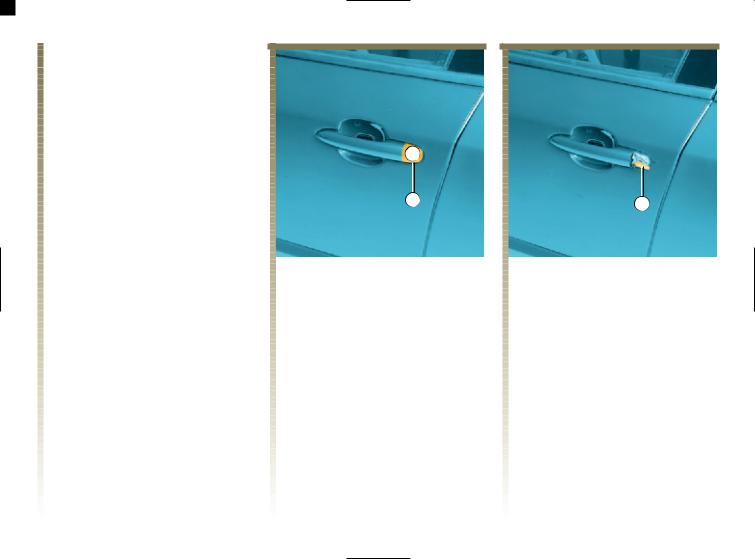
LOCKING/UNLOCKING THE DOORS
Locking/unlocking the doors from outside
This is done using the RENAULT Card; see the RENAULT Card information in Section 1.
In certain cases, the RENAULT Card may not work:
-vehicle located in a zone of high electromagnetic radiation;
-the use of equipment such as mobile phones etc., which operate on the same frequency as the card.
-flat RENAULT Card battery, discharged battery, etc.
It is possible:
-to use the emergency key (integrated into the card or, depending on the vehicle, separate) for the front left-hand door;
-to manually lock each of the doors;
-to use the interior locking/ unlocking door control refer to the information on Interior locking/ unlocking door control in Section 1.
A
1 |
Using the integrated security key 2
Remove cover A from the front left-hand door (using the base of the emergency key) at notch 1.
2 |
Insert key 2 into the lock and lock or unlock the door.
1.12
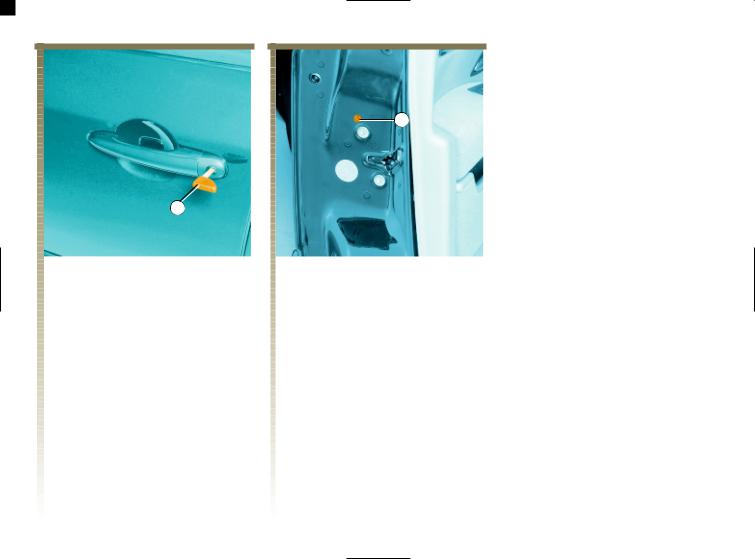
LOCKING/UNLOCKING THE DOORS (continued)
4
3
Using the separate emergency key 3 (depending on vehicle)
Insert key 3 in the left-hand door and lock or unlock the door.
Manual door locking
Turn screw 4 with the door open (using a tool such as a flat-head screwdriver) and close the door.
This means that the doors are then locked from the outside.
It can then only be opened from inside the vehicle.
1.13
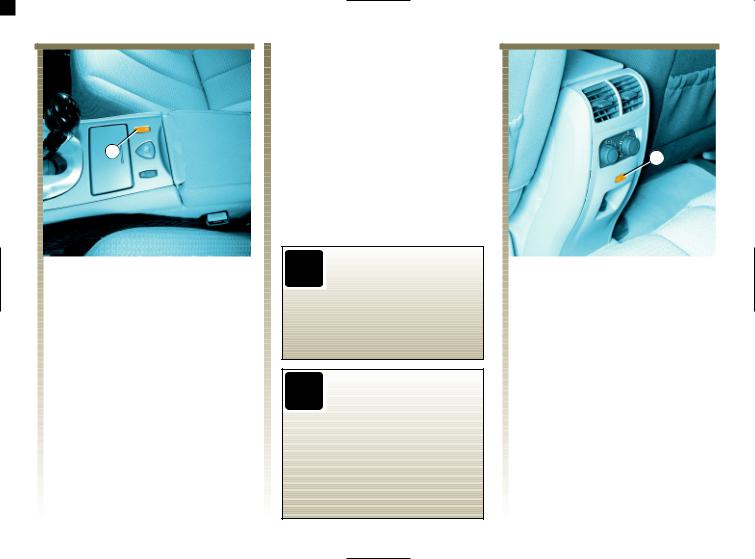
LOCKING/UNLOCKING THE DOORS (continued)
5
Interior locking/unlocking control
Switches 5 and 6 simultaneously control the doors, tailgate and fuel filler flap.
If a door or the tailgate is open or not properly closed, the door and tailgate lock/unlock quickly.
Locking the doors and tailgate without the RENAULT Card
With the ignition switched off and the front door open, press switch 5 for five seconds.
When the door is closed, all the doors and the tailgate will be locked.
It will only be possible to unlock the vehicle from outside using the RENAULT Card.
Never leave your vehicle
with the RENAULT Card
inside.
If you decide to keep the
doors locked when you
are driving, remember
that it may be more
difficult for those assisting you
to gain access to your vehicle in
the event of an emergency.
6
Opening element status indicator light
With the switched ignition on, the indicator lights integrated into switches 5 and 6 inform you whether or not the doors and tailgate are open:
-indicator light on, the doors and tailgate are locked;
-indicator light off, the doors and tailgate are unlocked;
When you lock the doors and tailgate from the outside, indicator light 5 remains lit for approximately one minute.
1.14
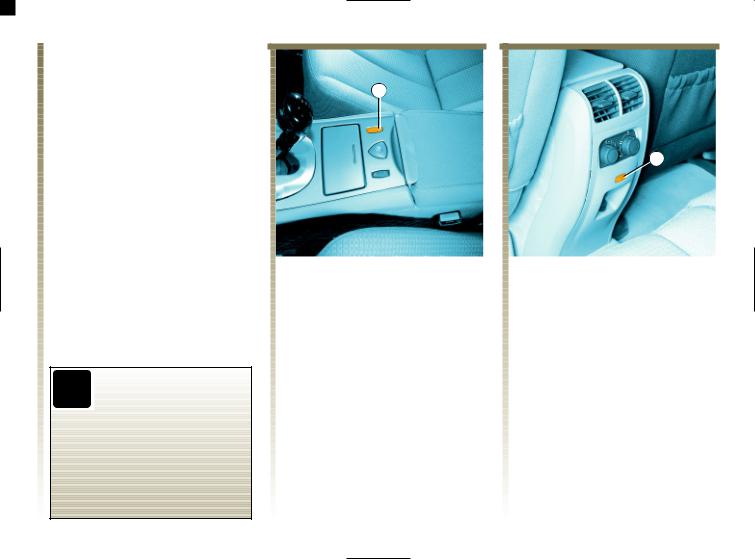
RENAULT ANTI-INTRUSION DEVICE
You can decide to activate this function if you wish.
To activate
With the ignition on, press the central door locking button 1 on the locking side (padlock side) for approximately 5 seconds, until you hear the beep.
To deactivate
With the ignition on, press the central door locking button 1 on the unlocking side (opposite the padlock) for approximately 5 seconds, until you hear the beep.
If you decide to keep the
doors locked when you
are driving, remember
that it may be more
difficult for those assisting you
to gain access to your vehicle in
the event of an emergency.
1 |
Operating principle
When the vehicle moves off, the system locks the doors automatically as soon as you reach a speed of 6 mph (10 km/h).
The door is unlocked:
-by opening a front door (vehicle stationary).
Note: If a door is opened, it will automatically be locked again when the vehicle reaches a speed of approximately 6 mph (10 km/h).
-by pressing the door unlocking buttons 1 or 2.
2
Faults
If you note a fault (no automatic locking, warning lights into buttons 1 and 2 do not light up when the doors are locked, etc.), first check that that all the doors and the tailgate are closed properly. If they are closed correctly, consult your RENAULT Dealer.
1.15
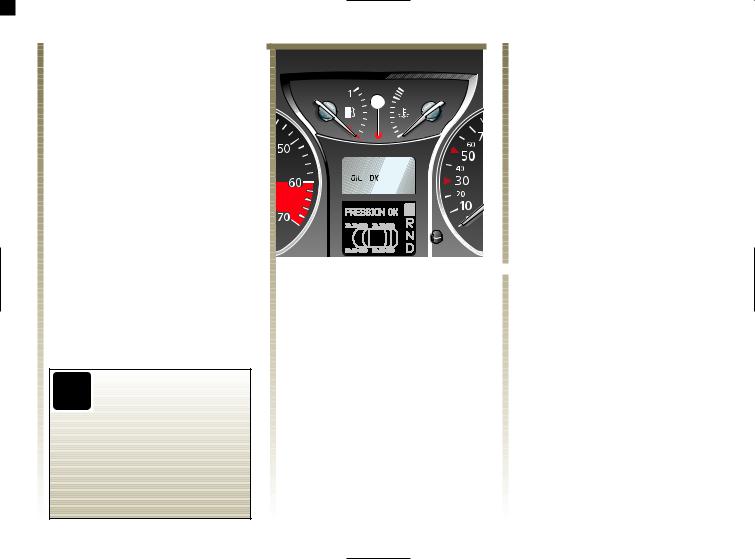
ENGINE IMMOBILISER
This prevents the vehicle being driven by anyone not in possession of the vehicle's RENAULT Card.
The vehicle is automatically protected a few seconds after the RENAULT Card is removed from the card reader.
|
Any unauthorised work |
|
carried out on the engine |
|
immobiliser (computers, |
|
wiring, etc.) could be |
dangerous. It must be carried out |
|
by |
trained RENAULT network |
personnel. |
|
1.16 |
|
1
Operating principle
When the ignition is switched on, (RENAULT Card fully inserted in the reader) indicator light 1 lights up for a few seconds and then goes out.
The vehicle has recognised the code and the engine can be started.
If the vehicle does not recognise the code, indicator light 1 and the reader will flash continuously (rapid flashing) and the vehicle cannot be started.
 Indicator lights
Indicator lights
Vehicle protection indicator light
A few seconds after the ignition has
been switched off, indicator light 1
will flash continuously.
The vehicle will not be protected until the RENAULT Card has been taken out of the card reader.
Engine immobiliser operating indicator light
When the ignition is switched on (RENAULT Card fully inserted), you can start the engine. Indicator light 1 lights up for approximately three seconds and then goes out.
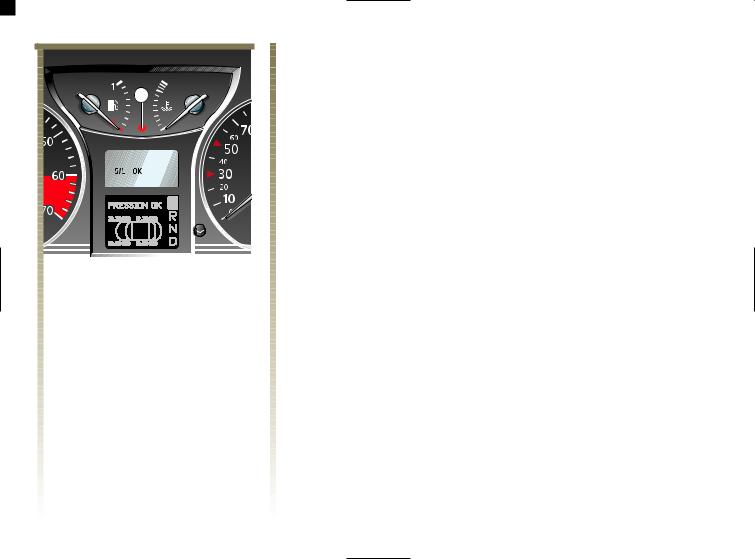
ENGINE IMMOBILISER (continued)
1
Operating fault indicator light
After the ignition has been switched on (RENAULT Card fully inserted), if indicator light 1 continues to flash or remains lit up, this indicates that the system is not operating correctly.
If the RENAULT Card is faulty (rapid flashing of indicator light 1 and the card reader), use the second RENAULT Card (delivered with the vehicle) if possible.
In all cases, it is essential to consult a RENAULT Dealer as only he is qualified to repair the engine immobiliser.
1.17
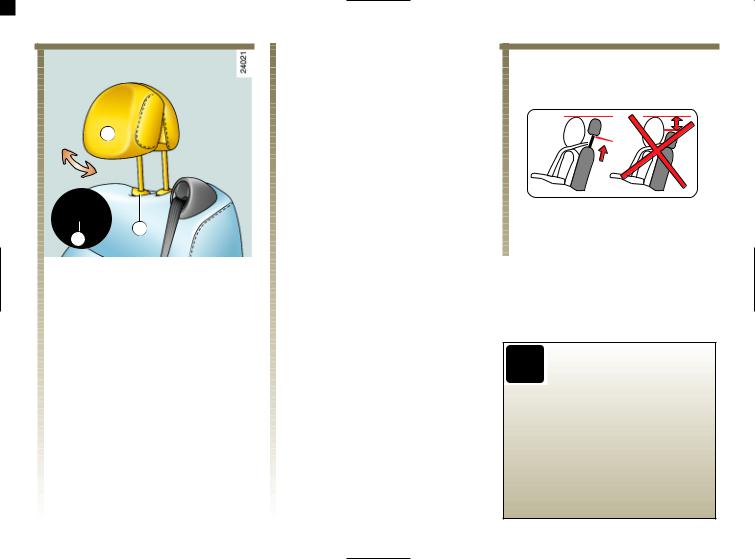
FRONT HEADREST
A
1
1
Headrest with tab 1
To adjust the height
While sitting on the seat, pull the headrest towards you and slide it up or down at the same time.
To remove the headrest
With the headrest in high position, raise tab 1, then lift the headrest until it is removed.
To adjust the angle of the headrest
The angle of the headrest can be adjusted. To do this, move the front section A of the headrest forwards or backwards until it feels comfortable.
To refit the headrest
Insert the rods into the sleeves, with the notches facing the front.
Lower the headrest until it locks in position.
The headrest is important
for safety. Ensure that it is
in place and in the correct
position. The distance
between your head and the
headrest should be as small as
possible. The top of your head
should be in line with the top of the
headrest.
1.18
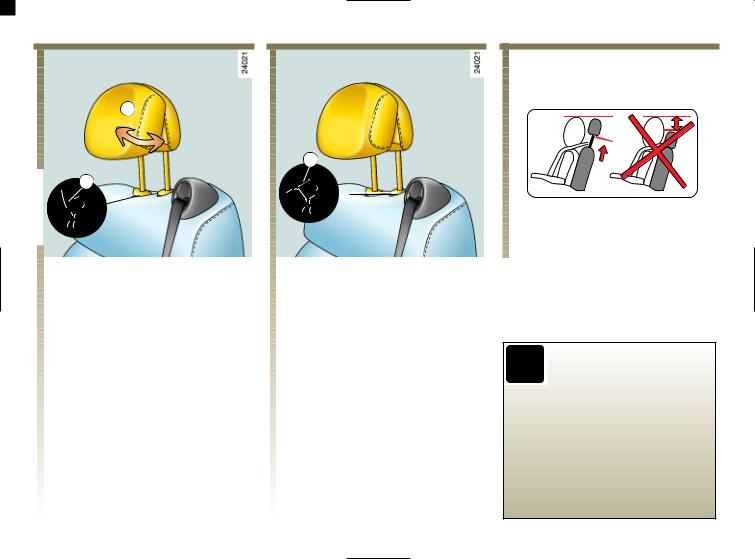
FRONT HEADRESTS (continued)
A
2
Headrest with tab 2
To fit the headrest
Slide it upwards to the required height.
To lower the headrest
Move tab 2 forwards and lower the headrest down to the required height.
To adjust the angle of the headrest
Depending on the vehicle, tilt section A towards or away from you to the required position.
3
To remove the headrest
Press button 3 and lift the headrest to release it.
To refit the headrest
Insert the headrest rods into the sleeves, with the notches facing forwards.
Press on tab 2 and lower the headrest to the required height.
The headrest is important |
||
for safety. Ensure that it is |
||
in place and in the correct |
||
position. |
The |
distance |
between your head and the |
||
headrest should be as small as |
||
possible. The top of your head |
||
should be in line with the top of the |
||
headrest. |
|
|
1.19
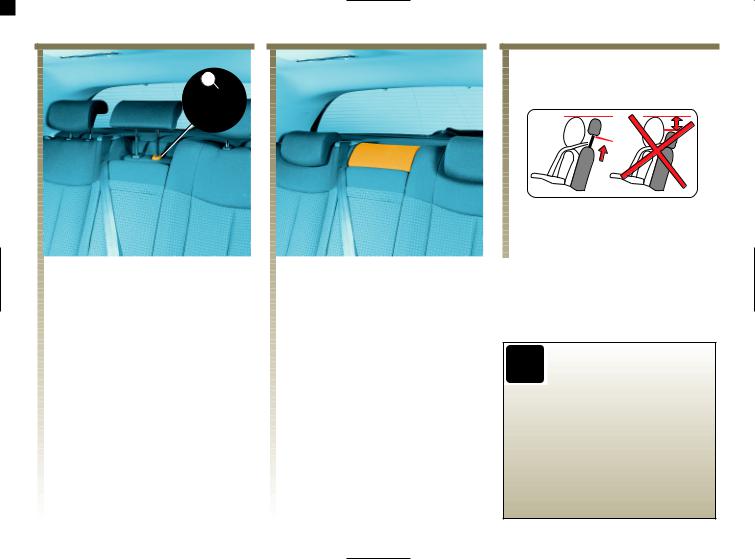
REAR HEADREST
1 |
To adjust the height
Pull the headrest towards you and slide it at the same time.
To remove the headrest
Press tab 1.
To refit the headrest
Insert the rods into the sleeves, with the notches to the front, and lower the headrest to the desired height.
Storage position for the rear headrests
Press tab 1 and lower the headrest completely.
The fully lowered position of the headrest is a storage position: it should not be used when the seat is occupied.
The headrest is important |
||
for safety. Ensure that it is |
||
in place and in the correct |
||
position. |
The |
distance |
between your head and the |
||
headrest should be as small as |
||
possible. The top of your head |
||
should be in line with the top of the |
||
headrest. |
|
|
1.20
